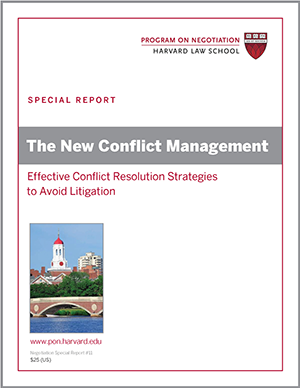
In international development, cross-cultural conflict resolution, and many other realms, Westerners have often been criticized for taking a paternalistic, top-down approach to implementing programs and training—and overlooking local practices and conditions in the process. Such one-size-fits-all approach to conflict resolution and negotiation training is often unsuccessful in the long term, as it ignores the cultural appropriateness of certain strategies, is often overly individualistic, and advocates for short-term solutions that encourage dependency rather than empowerment.
In his groundbreaking 1995 book, Preparing for Peace: Conflict Transformation Across Cultures, peace builder and scholar John Paul Lederach criticizes international conflict-resolution education for being overly prescriptive and biased toward Western approaches and values. Lederach argues for an “elicitive” approach, one in which mediation educators immerse themselves in a culture and, collaborating with local experts, incorporate what they have learned into their teaching.
In a recent article in the newly open-access Negotiation Journal, now available free worldwide from MIT Press, Peter T. Coleman, Lan H. Phan, and Anupriya Kukreja build on Lederach’s distinction between prescriptive (top-down) and elicitive (bottom-up) approaches to conflict resolution education in diverse cultures, noting that most cross-cultural conflict resolution education continues to take a prescriptive approach. Rather than arguing for this strategy to be thrown out in favor of a more collaborative, elicitive approach, they instead advocate for combining the best of both worlds.
The authors recommend that conflict resolution educators adopt an adaptive or hybrid approach to their work, noting that more elicitive, collaborative training tended to be more effective—“culturally relevant, sustainable, and culturally sensitive”—but that more traditional prescriptive, top-down training tended to be more efficient, saving time and money, at least in the short term. They have developed a free app for Android and Apple devices that is based on their findings and organized around five diagnostic questions. The combined responses to these questions will point the instructor initially toward emphasizing prescriptive or elicitive methods—or a hybrid approach.
In a postscript to the article, Lederach reflects on Coleman, Phan, and Kukreja’s work and how it connects to his own experiences.
Striking a Better Balance
The researchers interviewed expert mediation trainers, who offered advice designed to help other cross-cultural conflict resolution educators balance the two approaches—prescriptive and elicitive. Three of their insights are summarized as follows:
- Know yourself. Educators stressed the importance of setting aside their own biases when offering conflict resolution training in a new community. For example, two educators—one Protestant, one Catholic—who had worked with political prisoners during the conflict in Northern Ireland had to face the fact that some of the participants in their training programs had murdered members of their communities. “They had to check their own responses, so as not to allow . . . their personal histories with the ‘Troubles’ to derail their objectives in the training,” write Coleman and colleagues.
- Show deep respect for local values, knowledge, and practices. The key to establishing “trusting, long-lasting relationships with local leaders and other stakeholders” is to show great respect for the negotiation location, including the culture’s values, according to the authors.
An educator who worked with Indigenous tribes in Northern California and majority white organizations doing land conservation work noticed that those from the white organizations tended to want to get down to business right away when a meeting started. By contrast, the Native people instead often opened meetings with questions seemingly unrelated to the topic at hand, such as: “How’s the weather where you are? What do you see outside your window? How has it been this morning before we got on the phone?”
Rather than dismissing this as trivial “small talk,” the educator recognized that such questions served a valuable purpose by helping participants “feel centered in the conversation.” The authors conclude, “Such contrasting approaches can be carefully woven together to help establish a respectful sense of place and purpose.”
- Be open to candid feedback and corrections from locals. One educator who was offering negotiation training in Germany noted that many participants seemed to view compromise as a weakness rather than an integral aspect of negotiation, as he believed it to be. While he tried to convince them of the potential benefits of compromise, he remained at a standstill on the issue. “This forced him to rethink his framing of the conversation to deemphasize compromise and explore adjacent tactics,” according to the authors.
The anecdote highlights the importance of incorporating feedback from locals in cross-cultural conflict resolution, even if that feedback seems to be at odds with a seemingly more collaborative, elicitive approach. “Ultimately, the power to decide what type of educational experience would best serve the current needs of the community should remain with the community,” write the authors.
For more on the latest developments in negotiation and conflict resolution, check out the latest issue of Negotiation Journal, now available for free online.
What lessons have you learned about cross-cultural conflict resolution from your own experiences?




